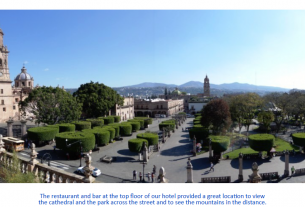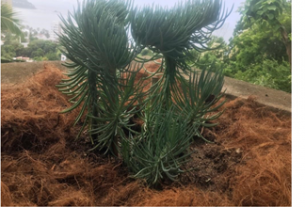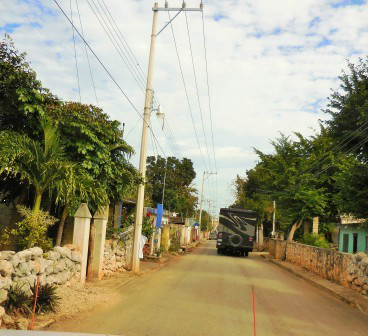By Dan and Lisa Goy on the October 2020 Edition
 Since our first visit to Baja, in 1985, what remains constant is change, nowhere more apparent than the change we have witnessed in Los Cabos (San José del Cabo to Cabo San Lucas with a 30 km (18 mile) corridor running between them). At the time, the current four-lane highway between Cabo San Lucas and San José del Cabo had only commenced construction very near Cabo San Lucas. We still recall 2 or 3 workers with shovels, a couple of wheelbarrows and a mule and saying to each other “this could take a while!” There was literally nothing in between the two towns other than the several RV communities on the beach.
Since our first visit to Baja, in 1985, what remains constant is change, nowhere more apparent than the change we have witnessed in Los Cabos (San José del Cabo to Cabo San Lucas with a 30 km (18 mile) corridor running between them). At the time, the current four-lane highway between Cabo San Lucas and San José del Cabo had only commenced construction very near Cabo San Lucas. We still recall 2 or 3 workers with shovels, a couple of wheelbarrows and a mule and saying to each other “this could take a while!” There was literally nothing in between the two towns other than the several RV communities on the beach.
 The most popular of these were the El Tule Arroyo, also Playa Chileno (Shipwreck Beach), Playa Santa Maria and Playa Viudas (Widows’ Beach), Playa Medano (known now as “The Office”). With the exception of El Tule, all were swimmable, some with coves and lots of snorkeling. There were groups of 25 or more RV communities settled in for the winter with many other beaches also hosting campers. You can still walk an old access road adjacent to the Villa Serena residential complex that takes you down to the beach where RVs once parked.
The most popular of these were the El Tule Arroyo, also Playa Chileno (Shipwreck Beach), Playa Santa Maria and Playa Viudas (Widows’ Beach), Playa Medano (known now as “The Office”). With the exception of El Tule, all were swimmable, some with coves and lots of snorkeling. There were groups of 25 or more RV communities settled in for the winter with many other beaches also hosting campers. You can still walk an old access road adjacent to the Villa Serena residential complex that takes you down to the beach where RVs once parked.
Within a few years, all the beach camping in this area was over and, with the completion of the 4-lane corridor, development truly took off. The last seashore camping in Los Cabos ended in 1991 with the closure of Shipwreck Beach to RVs (we camped here in 1985). Also popular at the time was the ferry service from Cabo San Lucas to Puerto Vallarta on the mainland. The terminal was out of town at a protected inner harbour. This service ended years ago, in 1989. This is now the Cabo San Lucas Marina.
 Sad news about all that great beach camping. The good news was all the RV parks and campgrounds that sprung up despite the relentless development in this newly found tourist paradise, supported by a world-class international airport.
Sad news about all that great beach camping. The good news was all the RV parks and campgrounds that sprung up despite the relentless development in this newly found tourist paradise, supported by a world-class international airport.
The 1990s were the heydays of the Los Cabos campground life-style with no less than 12 parks opening for all those Baja-bound Snowbird RVers.
Fast forward to the present day and the current state of affairs for camping in this Mexican paradise is nothing short of abys-mal. The last RV park that could accommodate any size of RV caravans, or size of RVs for that matter, closed in 2016. It was Villa Serena RV Park.
 In fact, we had reservations for our 2016/2017 Baja Amigos season and were forced to scramble to make alternate arrangements after being notified in late September of the closure.
In fact, we had reservations for our 2016/2017 Baja Amigos season and were forced to scramble to make alternate arrangements after being notified in late September of the closure.
We thought now would be timely for a walk down memory lane, fondly recalling all RV parks and campgrounds, some still open, but only a shadow of their former selves.
Cabo Glorieta RV Resort Park
This was probably the nicest RV park in Cabo San Lucas.  Back in the day, their website boasted “Welcome to our Corner of Paradise!!! After your adventurous drive down the Baja California Peninsula, come rest and relax at Cabo Glorieta RV Resort park in Cabo San Lucas, Mexico. The RV lifestyle can be everything you have imagined at our uniquely and beautifully de-signed Park, Cabo Glorieta RV Resort offers nothing less than the absolute best.”
Back in the day, their website boasted “Welcome to our Corner of Paradise!!! After your adventurous drive down the Baja California Peninsula, come rest and relax at Cabo Glorieta RV Resort park in Cabo San Lucas, Mexico. The RV lifestyle can be everything you have imagined at our uniquely and beautifully de-signed Park, Cabo Glorieta RV Resort offers nothing less than the absolute best.”
Designed as a giant traffic circle just 3 km north of Cabo San Lucas, this place was extremely popular and eventually the RVers built casitas or small homes on all the RV pads although there remain a few spaces for long-term RVs over the winter.
Paloma RV Village
This still exists today, on the north side of Hwy 1, up from the Corona Depository to the top of the hill, not far from Cabo Glorieta.
The RV park aspect of this “RV Village” has long since disappeared and again been replaced with well developed residences, sometime with the RVs buried inside.
 Brisa del Mar RV Resort
Brisa del Mar RV Resort
Opened in 1991, this was very popular with RV Snowbirds and the only RV park on the beach located on the corridor, just southwest of San José del Cabo, in between km 29 and km 30. This park had 50 full service sites, including 20 pull throughs, plus at least a dozen full-time residents including our friend Peter Cashmore who moved to Vagabundos and was a co-owner of the restaurant in that park.
We stayed there in 2005 and enjoyed the beach bar, pool and restaurant which included live entertainment. In 2007, the residents were told the park had been sold to developers and a condo project would start immediately. They were given 30 days to vacate. As of March 2017, the gates are locked, the site basically unchanged and the old sign still visible on the wall. We learned, as of the 2019/2020 season, work has finally begun on a hotel, 13 years after the residents were given 30 days’ no-tice to vacate in 2007.
El Arco Palapa RV Park
This park was located on the high side of the connector, at about the 5 km mark, north of Cabo San Lucas (near Costco), with a stunning view of the harbour and El Arco (the Arch). With 80 spaces, including 40 pull-through sites and many permanent residents located near the back, this was also a very popular RV park back in the day. It is hard to say when this park closed, as it really just deteriorated from inattention and neglect. We can say with some certainty that we saw no RVs in the front part of the campground as of 2010 and the site was actively being demolished as of the fall of 2016.
San Vicente Trailer Park
This park opened in 1981, only 3 km north of Cabo San Lucas across the highway from Walmart, with 34 spaces. We were not surprised to learn that a hotel developer from Las Mochis purchased the property to build a 5-star resort on the site and the place closed in 2008. We are also not surprised that as of 2017 the hotel has yet to be built.
El Marlin RV Park
Located at the corner of Boulevard Paseo de La Marina and Calle Melchor Ocampo in Cabo San Lucas, this park was a great location for those that wanted to be close to all the action only a block away from the marina. This was a small campground with only 16 spaces and closed in 2000.
Cabo Cielo RV Park
With a palm tree at each site, and a view of El Arco, this park was located at Km 3 of the Los Cabos corridor. Basically, an open field with 25 sites, this park closed in 2001.
El Faro Viejo RV Park
Located a dozen blocks north of the Cabo San Lucas harbour, this park was originally on a dirt road, considered to be out of town. With 28 big spaces, hook-ups, good bathrooms, a restaurant, bar and gift shop, this was once a popular in-town park. We dropped by in 2008 and the restaurant was definitely a going concern, the campground not so much, although the hook ups were still there. Not sure if they worked.
 Vagabundos del Mar Trailer Park
Vagabundos del Mar Trailer Park
This RV park was originally opened in 1987 by the Mexican Travel Club of the same name and sold to José Arballo years later. We really liked the park, as did our guests in the early years of Baja Amigos. The park was opened with almost 100 sites, 30-amp services, 2 washrooms with showers, a great restaurant, laundry and pool located only 3 km from Cabo on the beach side of the corridor.
This was a first operation for sure however, in 2013,  about a third of the park was sold to an auto dealership which eliminated all the RV snowbird traffic. All that remained was the restaurant, office, full-time residents at the back and washrooms. We continued to make a restaurant stop a highlight of our tours until we could no longer stay in Los Cabos. Sadly, the park was hit with a major flood in 2017 which wiped out the restaurant and all the permanent structures at the back. All that remains is a couple of spaces on the north wall between the office and the owner’s residence.
about a third of the park was sold to an auto dealership which eliminated all the RV snowbird traffic. All that remained was the restaurant, office, full-time residents at the back and washrooms. We continued to make a restaurant stop a highlight of our tours until we could no longer stay in Los Cabos. Sadly, the park was hit with a major flood in 2017 which wiped out the restaurant and all the permanent structures at the back. All that remains is a couple of spaces on the north wall between the office and the owner’s residence.
Club Cabo Motel and Campground Resort
Located near Vagabundos, access is unfortunately from a narrow dirt road which can work for smaller RVs, not so much for bigger motorhomes. This is the last campground where RVers can stop in for a short stay, if they are not too large. With 15 spaces (more or less), it is important to review comments online about Club Cabo so you have some idea of what your experience will be. Last season, one of our competitors had reservations at Club Cabo for their 18 RV Baja caravan. This included several larger rigs.
In February of 2017, when we dropped into the San Lucas Plaza for our scheduled shopping and banking stop, we found sever-al of the large RVs on this tour camping on a side street next to Walmart. Yikes! In September of 2017, a flood ripped through the motel and campground and demolished it. It will not be rebuilt.
Villa Serena RV Park
When we could no longer stay at Vagabundos, we made the move to Villa Serena which had 60 spaces, at Km 7, across from Home Depot. Very basic, lots of traffic noise from the corridor, it was easy in and out and worked for us and the other caravan companies. The restaurant on site by the same name was good for breakfast, pricey for anything else, but we were in Los Cabos where prices are expectedly higher. In the summer of 2016, we were notified that the park would not reopen for the 2016/2017 season and had been rezoned as a new Mega Shopping Centre. As of the 2019/2020 season the Villa Serena RV Park remained abandoned and looked much like it did in 2016.
 The RV Snowbird Future in Los Cabos
The RV Snowbird Future in Los Cabos
Clearly you will never see RV parks or campgrounds built any-where near the water or on the corridor between Cabo San Lucas and San José del Cabo again. This past season, the development on the connector was going stronger than we have ever seen before. At least ten large projects are on the go. How-ever, there is hope (and not just the town east of Vancouver, BC – some will get that reference).
A new inland highway runs from San José del Cabo to North Cabo San Lucas, a total of 30 kilometers (18 miles) that will be connecting Highway 1 with Highway 19. This Cabo bypass is finished and drivable and, from what we know, the properties on the highway-frontage remain available.
 Anywhere along this bypass would be a great location for a destination RV resort on the scale of anything we see in the southern US. When this happens, we are confident Los Cabos will again return to the glory days of the snowbird RV paradise of yesteryears.
Anywhere along this bypass would be a great location for a destination RV resort on the scale of anything we see in the southern US. When this happens, we are confident Los Cabos will again return to the glory days of the snowbird RV paradise of yesteryears.
History of Los Cabos
The indigenous Pericú names for San José del Cabo and Cabo San Lucas were Añiñi and Yenecami, respectively, with the cur-rent names given by the colonizing Spanish. The name of San José was given by Nicolás Tamaral, in honor of José de la Fuente Peña y Castrejón, the Marquis of Villa Puente who sponsored the mission. The appendix of “de Los Cabos” is to distinguish it from San José de Comondú as well as its proximi-ty to Cabo San Lucas. San José was also known as San Barnabé, as the nearby bay was named this.
Pirate Thomas Cavendish called Cabo San Lucas “Safe Port” as he hid there from Spanish authorities. The seal for the munici-pality of Los Cabos (referring to the two cities) was approved by the state government in 1981.
When the Spanish arrived, the main indigenous group in the area was the Pericú, a hunter-gatherer culture with stone-age tools. It is possible that these people arrived in the region with a more evolved culture which later simplified to adapt to the harsh conditions.
Evidence of this includes the region’s cave paintings as the peoples found by the Jesuits did not have an artistic tradition. The Pericú people and culture were distinct from other indigenous groups, first by being taller and second by being polygamous in a tribal organization. Their diet consisted of local seeds and fruits, as well as fish, reptiles, and small mammals. Men were in charge of large game hunting of deer.
Hernán Cortés himself arrived here in 1535 and named the Gulf of California the Sea of Cortés (Mar de Cortés) the name still used for it in Spanish. The harsh conditions impeded colonization by the Spanish, which did not begin in earnest until 1730, when Father José Echeverría and Father Nicolás Tamaral founded a mission in what is now San José del Cabo, in 1730. This date is considered the founding of the town, although a second ceremonial founding took place in 1822, when it was declared a town of the Baja California territory.

Diseases brought by Europeans devastated indigenous groups here and, in 1768, more missionaries arrived. While colonization was slow, the area was important as a way station for the Manila Galleon and other ships which stopped here for fresh water as well as fruits and vegetables. However, its remoteness also made it a place for pirates to hide. The first pirate in the area was Francis Drake, in 1578, followed shortly after by Thomas Cavendish, both after the treasures from Spain’s Asia trade.
One major attack was that on the Santa Ana Galleon, whose looting caused the Spanish colonial government to explore and map the area around Cabo San Lucas at the very beginning of the 17th century.
There were recommendations to establish a mission here, but this was rejected in favor of Loreto. This left Cabo San Lucas as a strategic hideout for English pirates until the 18th century. In 1709, pirate Woodes Rogers attacked the Nuestra Señora de la Encarnación y Desengaño. Hiding nearly a month in Cabo San Lucas, he also mapped the area and wrote detailed descriptions. He was followed by George Shelvocke, in 1721, who later published the oldest known drawings of the Pericú.
After Independence, the Baja Peninsula was part of the California province, but Cabo San Lucas was named head of a municipality. Its remoteness kept the area out of active participation of most of Mexico’s 19th and early 20th century tumultuous history. One exception was the Mexican American War. Resistance to US forces was organized in the small community of Santa Anita, near San José, headed by José Matías Moreno, Vicente Mejía and José Antonio Mijares, who was in charge of the marina at Cabo San Lucas.
One of the main streets in the town is now named after Mijares who died defending the town. The major political players during the Mexican Revolution were Manuel González and Pedro Orozco, along with Félix Ortega. In 1915, Ildefonso Green Ceseña, head of forces loyal to Venustiano Carranza, drove those of Francisco Villa out of the southern part of the peninsula.
Some development of the area began after the Mexican Revolution, with a lighthouse at Cabo Falso, as early as 1905, just southwest of Cabo San Lucas, in part to remind US ships in the waters here that the territory remained Mexican.

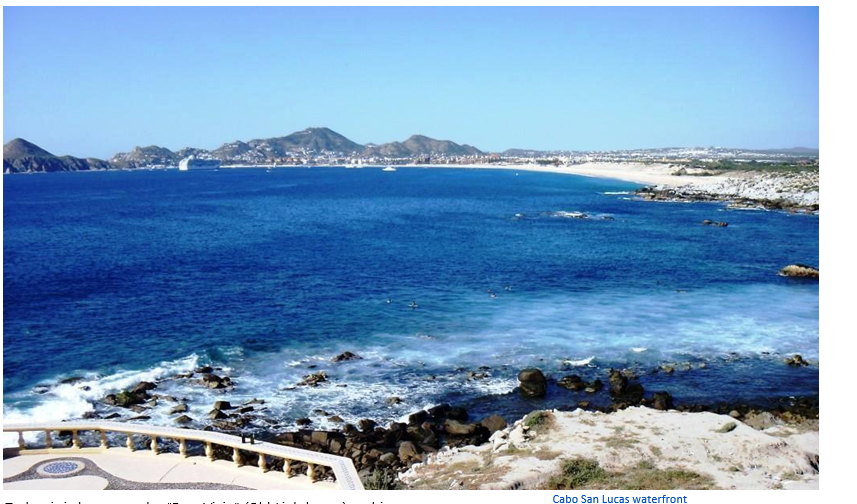
Today, it is known as the “Faro Viejo” (Old Lighthouse) and is a historic monument. In 1917, a US company began tuna fishing operations here and had a floating processing plant.
In 1927, the Compañía de Productos Marinos based its operations in Cabo San Lucas and helped develop the port to make it open to tourism later. In the 1920s, the first road connecting San José del Cabo and Cabo San Lucas was begun, but not completely finished until 1970.
Many newcomers to Los Cabos confuse the area’s history with its development as a tourist destination, so that the WWII-era pilots and businessmen who built the first hotels, and capitalized on the tremendous regional sportfishing, are sometimes lionized as “founding fathers.” This mistaken emphasis is not confined to tourists and transplants. Plaza Pioneros (in English, “Pioneer Plaza”) in Cabo San Lucas, for instance, is dedicated to these mid to late 20th century builders: men like Don Luis
Bulnes, Luis Cóppola and William Matt “Bud” Parr.
Certainly, all three deserve to be honored – as does Abelardo “Rod” Rodríguez for their immense contributions to the growth of Los Cabos. However, the area remained rural and un-developed until the latter 20th century, when the federal agency, Fonatur, began to develop a tourism industry here.
Development began with Cabo San Lucas for vacationers but then spread to San José del Cabo, with a different direction including more art galleries and promotion of its traditional Mexican character. The current municipality of Los Cabos was created in 1981, separated from the municipality of La Paz, with the seat at San José del Cabo. The town had previously been a municipal seat of a town of the same name in 1917 but lost this in a political reorganization in 1972. We first arrived in Los Cabos just as the 4 lane “connector” between Cabo San Lucas and San
Land’s End from the connector José del Cabo was starting construction. 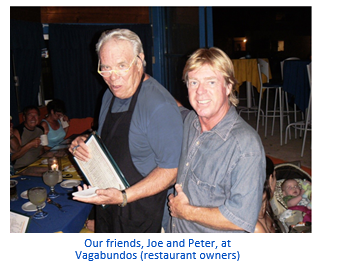
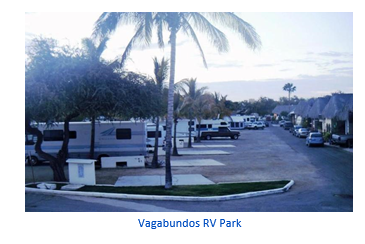
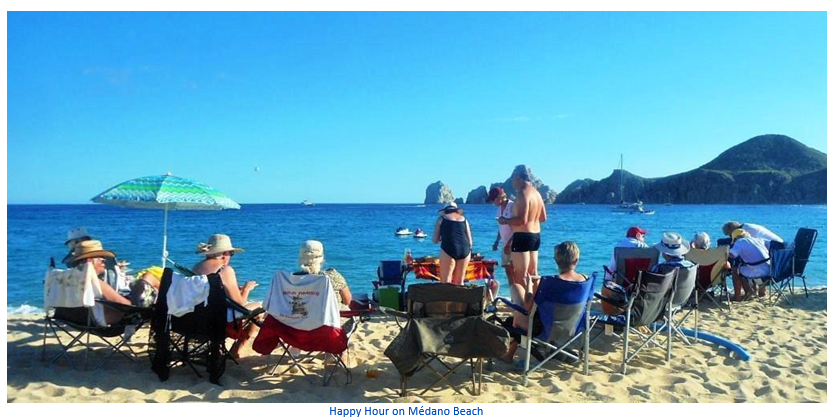
 |
 |
 |
 |
Dan and Lisa Goy, owners of Baja Amigos RV Caravan Tours, have been making Mexico their second home for more than 30 years and love to introduce Mexico to newcomers.

